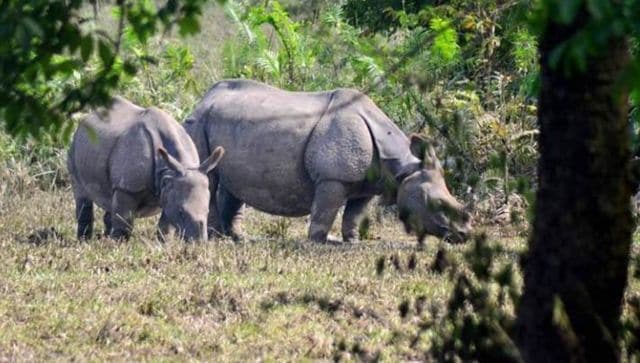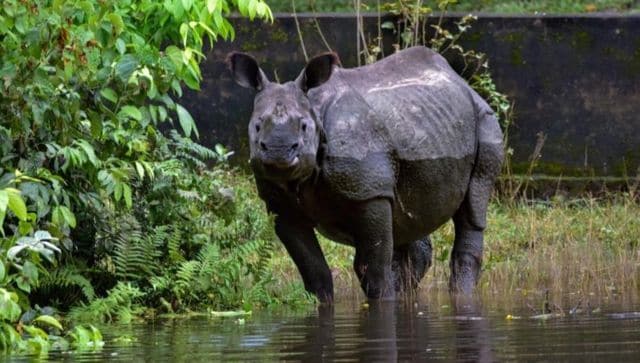In celebratory news for India, no rhinos were poached in Assam last year, state chief minister Himanta Biswa Sarma announced on Tuesday (2 January). “2022 was really special for our rhino conservation efforts. Not a single rhino being poached in 2022 & just 2 in 2021, the gentle giant is now much safer in Assam,” the Bharatiya Janata Party (BJP) leader said in a tweet.
Special director general of police (law and order) GP Singh also shared data on Twitter which showed 2022 was the first year in decades that no incident of rhino poaching was reported in Assam.
But, why are rhinos hunted? How severe is rhino poaching in Assam and how has the Northeast state been protecting the one-horned herbivore? We explain. Rhinos in India The Indian rhinoceros or Rhinoceros unicornis inhabit the Brahmaputra valley, some areas of North Bengal, and parts of southern Nepal, notes Indian Express.
The Indian rhino, which has one black horn and hard, grey-brown hide, is the largest of the rhino species.
Assam’s Kaziranga National Park (KNP) – located in the floodplains of the Brahmaputra river – is the biggest habitat for one-horned rhinos globally. The
animal’s population reached 2,613 at the park
last year, up from 2,413 in 2018. One-horned rhinos are also found in Orang National Park, Manas National Park and Pobitora Wildlife Sanctuary. [caption id=“attachment_11922962” align=“alignnone” width=“640”] Assam’s Kaziranga National Park (KNP) has 2,613 rhinos. PTI File Photo[/caption] The International Union for Conservation of Nature Red List places the herbivore in the vulnerable category. Earlier, the Indian rhino was on the endangered list. As per the WWF, the “recovery of the greater one-horned rhino is among the greatest conservation success stories in Asia”. Why rhinos are under threat
Poaching
is the biggest threat to rhinos, say experts. Even though there is no proven medical benefit, rhinos are hunted for their horns to treat a host of illnesses. The demand for rhino horns is in China and Taiwan mainly for the preparation of traditional medicines. Assam Forest Department said in a release in 2021 that “ground rhino horn is used in traditional Chinese medicine to cure a range of ailments, from cancer to hangovers, and also as an aphrodisiac”, reported Indian Express. The loss of the habitat of the animal and annual floods in Assam have also contributed to the dwindling figures of the massive rhino. As per the official data, as many as 400 rhinos have died since 2018 in the devastating floods in Assam. [caption id=“attachment_11922972” align=“alignnone” width=“640”]
Assam’s Kaziranga National Park (KNP) has 2,613 rhinos. PTI File Photo[/caption] The International Union for Conservation of Nature Red List places the herbivore in the vulnerable category. Earlier, the Indian rhino was on the endangered list. As per the WWF, the “recovery of the greater one-horned rhino is among the greatest conservation success stories in Asia”. Why rhinos are under threat
Poaching
is the biggest threat to rhinos, say experts. Even though there is no proven medical benefit, rhinos are hunted for their horns to treat a host of illnesses. The demand for rhino horns is in China and Taiwan mainly for the preparation of traditional medicines. Assam Forest Department said in a release in 2021 that “ground rhino horn is used in traditional Chinese medicine to cure a range of ailments, from cancer to hangovers, and also as an aphrodisiac”, reported Indian Express. The loss of the habitat of the animal and annual floods in Assam have also contributed to the dwindling figures of the massive rhino. As per the official data, as many as 400 rhinos have died since 2018 in the devastating floods in Assam. [caption id=“attachment_11922972” align=“alignnone” width=“640”] Annual flooding in Assam is also a threat to rhinos. PTI File Photo[/caption] Moreover, as flood waters inundate Kaziranga, the rhinos move uphill which makes them vulnerable to poaching. Recent poaching figures in Assam Assam witnessed 191 cases of rhino poaching in Assam between 2000 and 2021. In 2021 and 2020, two rhinos each were poached in the state, as per the data shared by the Assam chief minister. The highest cases of poaching were recorded in 2013 and 2014 with 27 incidents each. 18 poaching incidents were reported in 2016, which drastically dropped to six the next year and seven in 2018. In 2019, three rhinos were poached, says the official data. How Assam protects its rhinos In 2019, the Assam government constituted a Special Rhino Protection Force to stem rhino poaching at Kaziranga National Park. In 2021, the BJP-led Assam government, which had set a target of zero poaching, established a 22-member task force led by GP Singh. The force consists of senior forest officers and superintendents of police (SPs) of at least 11 districts including Golaghat, Nagaon, Karbi Anglong, Biswanath, Sonitpur, Darrang, Morigaon, Baksa,Chirang, Barpeta and Majuli. Divisional forest officers of six wildlife divisions are also part of the team, as per a Deccan Herald report. The coordinated efforts of forest and police departments have been fruitful in preventing poaching incidents, chief wildlife warden MK Yadava told Hindustan Times (HT). “We have intelligence both from forest and police sources about activities and movements of poachers, which helps in action against them,” Yadava added. Explaining the work of the task force, Singh told Deccan Herald, “Data about all past poachers and their present activities were collected, mapping of all boatmen was done, CCTVs (including night vision) were installed on the entry and exit points and all those engaged in the task were asked to adopt a zero tolerance policy. People living near the forests were sensitised while co-ordination with police in neighbouring Nagaland, Arunachal Pradesh and Manipur was streamlined.” Many armed commandos have also been deployed in rhino habitats to keep an eye on poachers. Drones and dog squads also help in tracing the movement of poachers in Assam. Touted as India’s first dog squad for wildlife crimes, the
‘K9 unit’ – established in Assam in 2011 by biodiversity organisation ‘Aaranyak’
– sniffs out hunters at national parks and wildlife sanctuaries. Four poachers were killed and 58 others were arrested since the task force was set up, as per the Deccan Herald report. Bibhab Talukdar, the CEO of Aaranyak, appreciated the government’s efforts to stem poaching incidents. “But they have mostly been Kaziranga-centric. The authorities must focus on Orang, Manas and Pobitora as well as frustrated poachers, who are well organised and might make attempts in those areas,” he told HT. To tackle the flooding threat faced by rhinos, authorities have built high mud platforms where the animal can take refuge during the monsoon season. Moreover, several NGOs such as the Centre for Wildlife Rehabilitation and Conservation (CWRC) also lead the conservation efforts. With inputs from agencies Read all the
Latest News
,
Trending News
,
Cricket News
,
Bollywood News
, India News
and
Entertainment News
here. Follow us on
Facebook
,
Twitter
and
Instagram
.
Annual flooding in Assam is also a threat to rhinos. PTI File Photo[/caption] Moreover, as flood waters inundate Kaziranga, the rhinos move uphill which makes them vulnerable to poaching. Recent poaching figures in Assam Assam witnessed 191 cases of rhino poaching in Assam between 2000 and 2021. In 2021 and 2020, two rhinos each were poached in the state, as per the data shared by the Assam chief minister. The highest cases of poaching were recorded in 2013 and 2014 with 27 incidents each. 18 poaching incidents were reported in 2016, which drastically dropped to six the next year and seven in 2018. In 2019, three rhinos were poached, says the official data. How Assam protects its rhinos In 2019, the Assam government constituted a Special Rhino Protection Force to stem rhino poaching at Kaziranga National Park. In 2021, the BJP-led Assam government, which had set a target of zero poaching, established a 22-member task force led by GP Singh. The force consists of senior forest officers and superintendents of police (SPs) of at least 11 districts including Golaghat, Nagaon, Karbi Anglong, Biswanath, Sonitpur, Darrang, Morigaon, Baksa,Chirang, Barpeta and Majuli. Divisional forest officers of six wildlife divisions are also part of the team, as per a Deccan Herald report. The coordinated efforts of forest and police departments have been fruitful in preventing poaching incidents, chief wildlife warden MK Yadava told Hindustan Times (HT). “We have intelligence both from forest and police sources about activities and movements of poachers, which helps in action against them,” Yadava added. Explaining the work of the task force, Singh told Deccan Herald, “Data about all past poachers and their present activities were collected, mapping of all boatmen was done, CCTVs (including night vision) were installed on the entry and exit points and all those engaged in the task were asked to adopt a zero tolerance policy. People living near the forests were sensitised while co-ordination with police in neighbouring Nagaland, Arunachal Pradesh and Manipur was streamlined.” Many armed commandos have also been deployed in rhino habitats to keep an eye on poachers. Drones and dog squads also help in tracing the movement of poachers in Assam. Touted as India’s first dog squad for wildlife crimes, the
‘K9 unit’ – established in Assam in 2011 by biodiversity organisation ‘Aaranyak’
– sniffs out hunters at national parks and wildlife sanctuaries. Four poachers were killed and 58 others were arrested since the task force was set up, as per the Deccan Herald report. Bibhab Talukdar, the CEO of Aaranyak, appreciated the government’s efforts to stem poaching incidents. “But they have mostly been Kaziranga-centric. The authorities must focus on Orang, Manas and Pobitora as well as frustrated poachers, who are well organised and might make attempts in those areas,” he told HT. To tackle the flooding threat faced by rhinos, authorities have built high mud platforms where the animal can take refuge during the monsoon season. Moreover, several NGOs such as the Centre for Wildlife Rehabilitation and Conservation (CWRC) also lead the conservation efforts. With inputs from agencies Read all the
Latest News
,
Trending News
,
Cricket News
,
Bollywood News
, India News
and
Entertainment News
here. Follow us on
Facebook
,
Twitter
and
Instagram
.
)